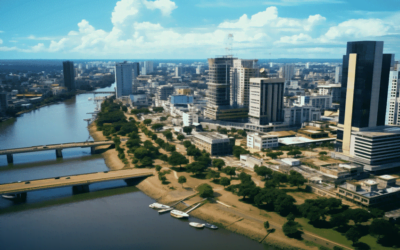Hey there, fellow drone enthusiast! Are you searching for the lowdown on Taiwan’s drone laws? I get it; navigating the regulations can be a bit of a maze.
Whether you’re a newbie eager to explore the skies or a seasoned pro looking for the latest updates, understanding the rules is crucial. Don’t worry; I’ve got your back.
You see, I’ve dived deep into the world of “Country Drone Laws,” conducting extensive research to provide you with the most up-to-date and comprehensive insights.
I’ve scoured through official documents, consulted experts, and analyzed recent developments. So, rest assured, I’ve got the answers to your burning questions about flying drones in Taiwan.
If you’re seeking a solution to your drone-related queries, you’re in the right place. In the upcoming sections, I’ll break down Taiwan’s drone laws, explaining the intricacies, restrictions, and crucial things you need to know.
So, why not dive into this guide and discover how you can take to the Taiwanese skies with confidence? Let’s get started!
Registration and Permits

Let’s dive into the nitty-gritty of registration and permits, a crucial part of Taiwan’s drone laws. Understanding this process is like getting your passport stamped before traveling to a new country – it’s the first step to exploring the skies legally.
Requirement to register drones with the Civil Aeronautics Administration (CAA)
So, here’s the deal: if your drone tips the scales at more than 250 grams in Taiwan, you need to register it with The Taiwan Civil Aeronautics Administration (CAA). It’s like getting a license for your car but for the air.
This registration process helps the authorities keep track of drones in use and ensure they are operated safely. Remember, even though this might sound bureaucratic, it’s all about ensuring everyone’s safety in the skies.
Operator permits and when they are necessary
Now, about operator permits. If you’re planning to use your drone for commercial purposes or venture into specific restricted areas, you might need one. Think of it as a special driver’s license for professional drone pilots.
The requirements for obtaining one can vary based on your drone’s size, the intended use, and the location. It may seem like a bit of extra paperwork, but these regulations exist to maintain order and safety in the skies.
The importance of complying with these registration and permitting processes
Compliance with registration and permitting processes isn’t just a box to tick – it’s about being a responsible drone operator. It’s essential to follow these rules to ensure your drone flights are safe and legal.
By adhering to these regulations, you’re not only staying on the right side of the law but also contributing to the overall safety of the airspace.
Plus, it’s always better to fly with a sense of security, knowing you’ve got the green light from the authorities. So, when you’re ready to take your drone for a spin in Taiwan, remember to start with proper registration and permits.
Also Read: Drone Regulations in Syria 2024
No-Fly Zones

Picture this: the sky’s the limit, but not everywhere. No-fly zones are like the “Do Not Enter” signs in the world of drones. Let’s explore what they mean and what happens if you venture where you shouldn’t.
Explanation of the concept of no-fly zones
No-fly zones are the areas where drone operations are strictly prohibited. Think of them as off-limits airspace segments.
These restrictions are put in place for a reason, often to safeguard critical infrastructure, public safety, and national security. In other words, they’re like invisible boundaries that drone enthusiasts need to respect.
no-fly zones in Taiwan, such as airports, military bases, and government buildings
Now, you’re probably curious about what these zones look like in Taiwan. Well, common no-fly zones include airports, military bases, and government buildings.
It’s a no-brainer, right? These locations house sensitive operations and infrastructure, so flying your drone in these areas can be risky business. Avoiding them is not only a legal obligation but also a matter of common sense.
Consequences of flying in prohibited areas
So, what if you ignore the no-fly zones and take your drone where it’s not supposed to go? Well, that’s when the consequences start piling up.
The authorities take these regulations seriously, and you could face hefty fines, legal trouble, and even damage to your drone’s reputation.
More importantly, you risk endangering others and causing disruptions in sensitive areas. In other words, it’s a lose-lose situation. Staying out of no-fly zones is a smart move for both your drone and the safety of the skies.
Also Read: Drone Regulations in Switzerland 2024
Altitude Restrictions

Let’s talk about reaching for the skies but with some boundaries in place. Altitude restrictions for drones in Taiwan are like having a speed limit on the highway – they’re there for everyone’s safety.
Description of the maximum permitted altitude for drone flights in Taiwan
In Taiwan, drone enthusiasts need to keep their aircraft under 120 meters (approximately 394 feet) above ground level.
This might seem like it’s putting a cap on your airborne adventures, but it’s essential for ensuring that drones don’t interfere with manned aircraft, which cruise at higher altitudes. Think of it as a fair share of the sky, where everyone can coexist safely.
Importance of adhering to altitude limits to ensure safety and prevent airspace violations
Adhering to these altitude limits is not just about following the rules; it’s about being a responsible drone pilot. Flying too high can pose risks, not only to your drone but also to other aircraft and people on the ground.
It’s all about maintaining safety and harmony in the airspace. Staying within the specified altitude ensures that your drone operates in a way that’s considerate of other users of the airspace. So, while the sky’s the limit for your drone, there’s a reasonable ceiling to ensure safety and prevent any airspace violations.
Also Read: Drone Regulations in Sweden 2024
Remote ID and Tracking

Now, let’s chat about a pretty cool tech requirement for drones in Taiwan: remote identification and tracking systems. These innovations are like the digital license plates of the drone world, and they play a vital role in ensuring safety and accountability.
Requirements for drones to be equipped with remote identification and tracking systems
In Taiwan, drone operators may need to equip their drones with remote identification and tracking systems. These systems allow authorities to monitor and identify drones in real-time, much like how a GPS tracker works. It provides crucial data about the drone’s location, its operator, and other essential information.
Think of it as making your drone visible in the digital sky. Compliance with these requirements is essential, especially for those operating in areas where it’s mandatory. This not only keeps you on the right side of the law but also contributes to the overall safety and transparency of the airspace.
Importance of these systems in enhancing accountability and safety
These systems are game-changers when it comes to safety and accountability. They ensure that authorities can quickly identify and communicate with drone operators, which is crucial for managing airspace and responding to potential safety issues.
Remote ID and tracking systems make drone operations transparent and help prevent incidents by allowing real-time monitoring. So, while it might seem like a technical requirement, it’s a significant step forward in ensuring responsible and secure drone operations in Taiwan’s airspace.
Also Read: Drone Regulations in Suriname 2024
Safety Regulations

Safety is paramount when it comes to drone operations. Let’s delve into some essential safety guidelines that every drone enthusiast should be well aware of.
General safety guidelines for drone operations
Diving into the world of drone flying means embracing a few safety guidelines. These typically include flying during daylight hours, maintaining line-of-sight with your drone, and steering clear of airports and no-fly zones.
It’s like adhering to the rules of the road but for the skies. Following these guidelines helps ensure smooth and secure drone operations.
significance of maintaining a safe distance from people, property, and other aircraft
Maintaining a safe distance from people, property, and other aircraft is a golden rule in the drone world. Imagine this: drones can be a bit like mischievous seagulls, and they have been known to cause accidents when they get too close to people or buildings.
By keeping your drone at a safe distance, you protect both your aircraft and those on the ground. It’s all about sharing the airspace responsibly.
Mentioning flyaway prevention measures and emergency procedures
Now, let’s talk about a pilot’s worst nightmare: the dreaded flyaway. Sometimes, drones can lose their connection with the operator and wander off on their own. But don’t fret; there are measures to prevent flyaways, like calibrating your drone before flight and ensuring a strong GPS signal.
And in case things go awry, having emergency procedures in place, like returning to home, can save the day. It’s all about being prepared for the unexpected in the world of drone flying. So, remember, safety isn’t just a checklist; it’s a mindset that every responsible drone pilot should adopt.
Also Read: Drone Regulations in South Sudan 2024
Liability Insurance

Flying drones is a thrilling adventure, but it’s essential to understand the importance of liability insurance in this journey. It’s not just an option; it’s a fundamental aspect of responsible drone operation.
The necessity of liability insurance for drone operators
Liability insurance is like a safety net for drone operators. It’s not only necessary; it’s often a legal requirement in many regions, including Taiwan.
This type of insurance provides coverage in case your drone causes damage or harm to people, property, or other aircraft. Without liability insurance, you’re taking on considerable financial and legal risks, which is something no drone operator wants.
Coverage and benefits of having insurance in place
Liability insurance offers peace of mind. It covers a range of scenarios, from accidental collisions with property to unexpected mishaps during a flight.
If something goes wrong, your insurance can help cover the costs of repairs, medical bills, and legal fees. It’s like having a safety cushion to protect your finances and reputation.
Consequences of operating without proper insurance
Operating a drone without proper liability insurance is a risky endeavor. Without coverage, you could be personally responsible for significant expenses if your drone causes any damage or injury.
Legal consequences, fines, and damage to your reputation are also potential outcomes. Insurance isn’t just an expense; it’s an investment in ensuring that you’re protected when things don’t go as planned.
In the world of drones, responsibility, and preparedness go hand in hand, and having liability insurance is a significant step toward being a responsible operator.
Also Read: Drone Regulations in Sudan 2024
Prohibited Activities

Drones are incredible tools, but there are a few activities that are simply a no-go. Let’s explore what’s on the “do not attempt” list in the world of drone operations.
Activities that may be prohibited, such as night flights, flying over crowds, or sensitive areas
Prohibited activities often revolve around safety and respect for privacy and security. Some of the activities that might be restricted include night flights, flying over crowds, and entering sensitive areas.
Night flights, for example, can be challenging due to limited visibility, while flying over crowds and sensitive areas can pose significant risks and privacy concerns. It’s all about ensuring the well-being of both your drone and the people on the ground.
Consequences of engaging in prohibited activities
Consequences of engaging in prohibited activities can range from legal trouble to accidents. Violating these rules may lead to fines, legal repercussions, and damage to your drone’s reputation.
More critically, engaging in prohibited activities can put lives and property at risk. For instance, flying over a crowd could result in accidents if your drone malfunctions, and invading sensitive areas may disrupt critical operations.
So, it’s crucial to steer clear of these activities not just to follow the law but to ensure the safety and security of everyone involved. Responsible drone operators prioritize safety and adhere to these prohibitions to keep the skies and the ground safe.
Also Read: Drone Regulations in Sri Lanka 2024
Permits for Aerial Photography and Filming

Now, let’s explore a world of creativity and opportunity – special permits for aerial photography and filming. If you’re a drone operator with a passion for capturing breathtaking shots from the sky, this is an essential aspect of Taiwan’s drone laws you need to know.
Special permits are required for drone operators involved in aerial photography and filming
If you’re planning to use your drone for commercial aerial photography and filming in Taiwan, you’ll often need special permits.
These permits distinguish your drone operations from recreational flying and indicate that you’re using your drone for professional and artistic purposes. They’re like your backstage pass to capture stunning aerial shots legally.
Application process and criteria for obtaining these permits
To obtain these special permits, you’ll typically need to go through an application process with the relevant authorities. The specific criteria can vary, but generally, you’ll need to provide details about your drone, the intended locations and flight plans, and demonstrate your knowledge of safe drone operations.
It’s all about ensuring that drone operators involved in aerial photography and filming have the necessary expertise and follow regulations to maintain safety and respect for privacy.
So, if you’re ready to elevate your drone photography game, be sure to delve into the application process and requirements for these special permits. They’re your key to capturing breathtaking aerial imagery while adhering to the law.
Also Read: Drone Regulations in Spain 2024
Import and Export Regulations

When it comes to the drone world, it’s not just about where you fly but also where you get your equipment. Let’s explore the import and export regulations for drones and related gear in Taiwan.
import and export restrictions for drones and related equipment
Taiwan, like many countries, has specific regulations for the import and export of drones and related equipment.
These regulations are in place to ensure that the equipment meets safety standards and doesn’t compromise national security. When you’re importing or exporting drones, you’ll need to navigate these regulations to ensure a smooth process.
How to comply with these regulations when bringing drones into or out of Taiwan
To comply with these regulations, you’ll need to follow specific procedures when bringing drones into or out of Taiwan. This typically involves documentation, customs declarations, and adherence to safety and security standards.
Ensuring that your drone and related equipment meet the country’s requirements is essential to prevent any legal complications and to guarantee the safe and lawful use of your gear in Taiwan.
So, if you’re planning to bring your drones and equipment into or out of Taiwan, it’s essential to research and follow the import and export regulations carefully. This ensures that your equipment is compliant and that you can enjoy your drone adventures without any unnecessary legal hurdles.
Also Read: Drone Regulations in South Africa 2024
Final Thoughts on Taiwan Drone Laws

And there you have it, fellow drone enthusiasts – the ins and outs of Taiwan’s drone laws. Let’s wrap up this journey with some key takeaways and a final word of encouragement.
We’ve covered a lot of ground here, from registration and permits to no-fly zones, safety regulations, liability insurance, and the importance of respecting prohibited activities.
We’ve also delved into the world of special permits for aerial photography and filming and the crucial import and export regulations.
The most crucial aspect of this drone law odyssey is compliance. These rules aren’t just bureaucratic hurdles; they’re the framework that ensures safety, security, and order in the skies.
Compliance isn’t just about following the law; it’s about being a responsible and considerate drone operator, committed to safety, privacy, and respect for others.
As you embark on your drone adventures in Taiwan, remember that responsible and safe drone operation is key. Follow the rules, stay updated on the latest regulations, and prioritize safety on all your flights.
Whether you’re flying for fun or for capturing stunning aerial imagery, ensure that your passion for drones is coupled with a deep sense of responsibility.
So, fellow drone aficionados, go out there and soar high in the Taiwanese skies while being mindful of the laws that govern our beloved hobby.
The thrill of flying your drone legally is an adventure worth pursuing, and it’s an experience that can be enjoyed safely and responsibly by all.
Frequently Asked Questions on Taiwan Drone Laws
Are there specific requirements for drone registration in Taiwan?
In Taiwan, drones weighing more than 250 grams must be registered with the Civil Aeronautics Administration (CAA). This registration can be done online, and it’s a crucial step to ensure that your drone is operating legally. Compliance with this requirement is essential for responsible drone operation.
What are the consequences of flying in no-fly zones in Taiwan?
Flying in no-fly zones, such as airports, military bases, and government buildings, can lead to severe consequences. Violating these restrictions may result in legal trouble, hefty fines, and potential damage to your drone’s reputation. It’s not only about following the law but also ensuring the safety and security of these sensitive areas.
Do I need liability insurance to operate a drone in Taiwan?
Yes, having liability insurance is a necessity for drone operators in Taiwan. It’s not just a legal requirement; it’s a safeguard against potential damages and accidents. Liability insurance helps cover costs related to property damage, injuries, and legal expenses, ensuring that you’re financially protected while flying your drone.
What are the permitted altitudes for drone flights in Taiwan?
In Taiwan, drones are typically not allowed to fly above 120 meters (about 394 feet) above ground level. Adhering to these altitude limits is crucial for airspace safety, preventing conflicts with manned aircraft, and ensuring responsible drone operation.
How can I obtain permits for aerial photography and filming in Taiwan?
If you’re planning to use your drone for commercial aerial photography and filming in Taiwan, you’ll likely need special permits. The application process can vary, but you’ll generally need to provide details about your drone, and flight plans, and demonstrate your knowledge of safe drone operations. These permits are your gateway to capturing stunning aerial shots legally and professionally.













